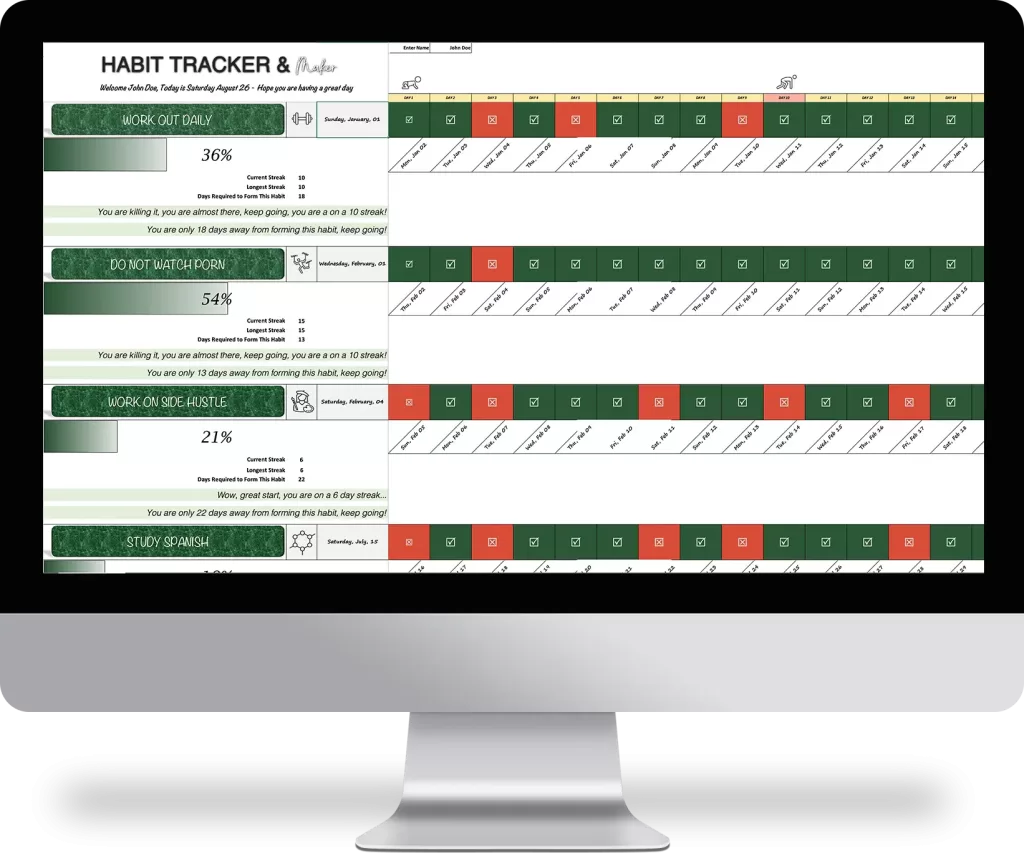Table of Contents
Introduction: The Power of Habits
The Evolution of Habit Trackers
From Pen to Pixel to Spreadsheet: A Guide on How to Track Daily Habits
Cultivating Healthy Habits: The Art and Science
Conclusion
1. Introduction: The Power of Habits
In the intricate tapestry of human behavior, there lies a hidden gem: the art of habit formation. It’s akin to watching the quiet build-up of a storm. These seemingly inconsequential daily repetitions gather momentum discreetly, and knowing how to track daily habits can be the turning point. Suddenly, these habits become the driving force behind seismic shifts in our lives.
2. The Evolution of Habit Trackers
- Stone Markings: Early humans might have used stones or sticks to keep count of their daily tasks or significant events. These rudimentary counting tools evolved over time, but the principle remained consistent: a physical representation of time or tasks completed.
- Personal Diaries & Journals: As literacy spread, people began to maintain diaries and journals. These weren’t just for recording events, but also for reflecting upon one’s actions and behaviors. The daily act of writing served as a method to track habits and introspect.
- Tally Systems: In some cultures, a tally system was used to mark days, tasks completed, or habits adhered to. This visual representation served as a reminder and a motivator.
- Religious & Philosophical Practices: Many cultures integrated habits into religious or philosophical practices. Whether it was daily prayers, meditations, or acts of kindness, adherents would keep track through repetition and community reinforcement.
The Modern Age:
Today, with the surge in technology and cognitive research, habit tracking has become more sophisticated and user-friendly.
- Digital Apps: Applications like HabitBull, Streaks, and Todoist help users set, track, and maintain habits with reminders, streak counts, and visual representations of progress.
- Wearable Tech: Devices like Fitbit or the Apple Watch track physical habits such as steps taken, hours of sleep, or heart rate. They provide real-time feedback, allowing users to adjust behaviors instantaneously.
- Online Communities: Websites and forums dedicated to habit formation offer communal support. Users share their progress, seek advice, and celebrate milestones, making the journey more collaborative and motivating.
- Smart Home Integration: With the advent of smart homes, habits are also being tracked and adjusted through integrated systems. For instance, a smart fridge can track your eating habits, while AI-powered systems can remind you to hydrate or take breaks.
In essence, while the tools and techniques have evolved dramatically, the fundamental human desire to understand, track, and better our daily habits remains a consistent thread through the tapestry of time.

3. From Pen to Pixel to Spreadsheet: A Guide on How to Track Daily Habits
The world of habit trackers presents a fascinating array, each with its distinct charm and potential pitfalls:
| Type of Habit Tracker | Pros | Cons |
|---|---|---|
| Bullet Journal Habit Trackers | – Customizable and flexible – Encourages creativity – Physical record | – Requires daily manual updating – Can be time-consuming to set up |
| Digital App Trackers | – Automated reminders – Digital backup – Easy data visualization | – Dependent on technology – Can have a learning curve |
| Printable Habit Trackers | – Convenient, ready-to-use – Can be pinned or displayed – Tangible record | – Not customizable – Can consume paper/resources |
| Mood and Habit Combination | – Insight into emotional patterns – Holistic approach – Motivational | – Might be too personal for some – Requires more introspection |
| Visual Representation Trackers | – Motivating through visuals – Fun and engaging – Easily see progress at a glance | – Limited customization – May not be detailed enough |
| Excel Trackers | – Highly customizable – Digital backup – Data analytics capabilities | – Steeper learning curve for some – Dependent on software compatibility |

4. Cultivating Healthy Habits: The Art and Science
Understanding how to track daily habits is just the first step. Cultivating and maintaining healthy habits requires a blend of motivation, discipline, and technique:
Start Small: Begin with manageable tasks to ensure consistency.
Build a Routine: Fix a time for your habits to make them second nature.
Accountability Partners: Engage a friend or family member for mutual motivation.
Visualize the Benefits: Understand the ‘why’ behind a habit for better motivation.
Limit Temptations: Make it easy to follow through by setting up your environment to support your new habit.
5. Conclusion
The expedition to harnessing our habits is ongoing, but with each step, and with the right tools and mindset, we come closer to mastering the enigma of our behaviors, steering them towards personal and collective betterment.





0 Comments